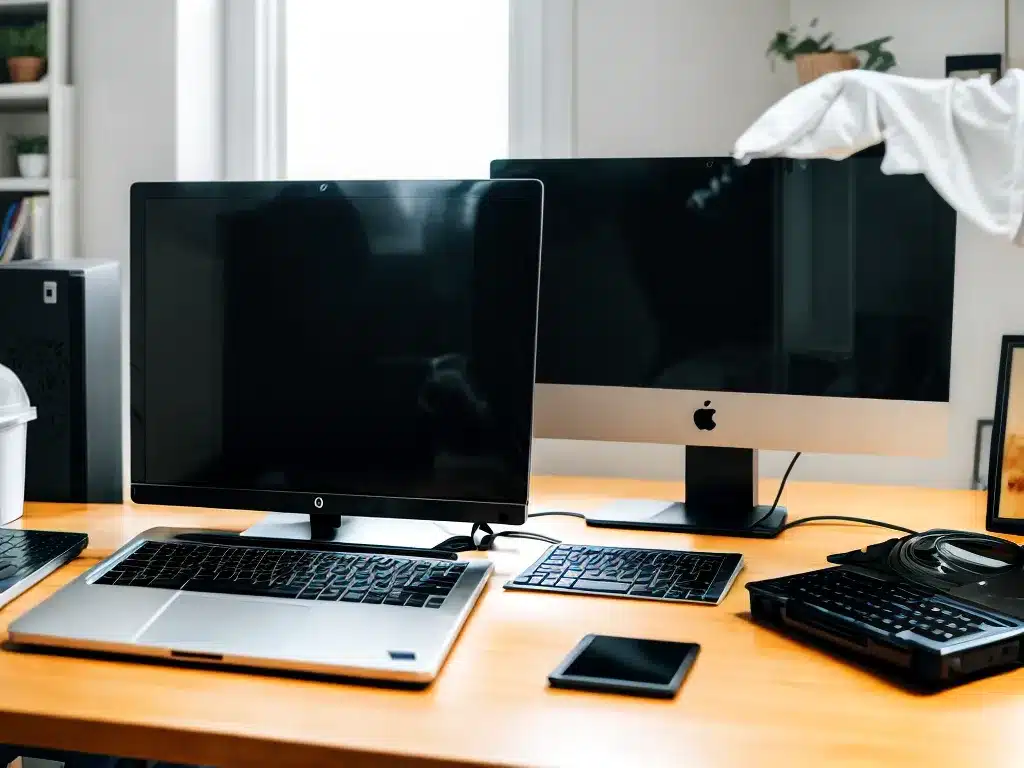
Why You Should Clean Out the Dust
Keeping my computer clean and dust-free is important for several reasons. Dust buildup inside a computer can cause overheating issues. It can clog up fans and ventilation ports, preventing heat from escaping. This can lead to computer components like the CPU and GPU overheating and thermal throttling, reducing performance.
Dust can also cause issues with sensitive components like RAM and the motherboard. It can get stuck in between contacts, causing memory errors or even preventing components from making proper contact. A buildup of dust on circuit boards can even potentially lead to short circuits.
In addition, a thick layer of dust just looks bad and detracts from the aesthetic of your PC build. No one wants to open up their case and see a gross mess of dust everywhere. Maintaining a clean interior helps your build retain that new computer look.
So in summary, here are the key reasons you should periodically clean out computer dust:
- Prevent overheating by ensuring proper airflow and ventilation
- Avoid issues with sensitive components like RAM and the motherboard
- Maintain the aesthetic look of your build over time
When to Clean Out Dust from Your Computer
I like to clean out my computer dust about every 3-6 months. However, if your computer is in a particularly dusty environment, you may need to clean it more frequently.
Some signs that indicate it’s time to clean out dust include:
- Fans have to spin faster and you notice more noise coming from the computer
- You open up the case and notice a visible layer of dust building up
- Your computer feels warmer than usual with hot air coming from the vents
- You are getting more program crashes or hardware errors than normal
Additionally, it’s a good idea to clean out computer dust whenever you notice a drop in performance. Overheating due to dust buildup can cause thermal throttling, so keeping your computer clean helps it run at full speed.
If you have pets that shed hair or live in a dusty climate, you may need to clean as frequently as every 1-2 months. Just keep an eye on your computer’s condition and clean when needed.
How to Clean Out Dust
Here is my step-by-step process for thoroughly cleaning dust out of my computer:
1. Power Off and Unplug the Computer
The first step is to power off and unplug the computer. This prevents any risks of electric shock while cleaning. Make sure it is completely powered down before opening up the case.
2. Open Up the Case
Use a Phillips screwdriver to remove the side panel screws and open up the case. Lay the side panel off to the side. This gives you access to all the components and makes it easier to clean.
3. Use Compressed Air
My preferred tool for removing dust is compressed air. Spray compressed air over components like the CPU cooler, GPU, power supply, case fans, and anywhere else you see a dust buildup. The powerful air blast will dislodge and blow away most of the dust.
4. Clean the Fans
Pay special attention to each fan in your case. Use a combination of compressed air and a soft-bristled brush to clean fan blades if needed. Remove any dust blocking the hub to allow each fan to spin freely.
5. Wipe Down Surfaces
For any remaining dust, use a microfiber cloth to lightly wipe down surfaces. Carefully wipe circuit boards, being cautious around sensitive components. A small hand-vac can also help sucks up loosened dust.
6. Check Air Vents
Check that all air vents and ports are free of dust obstruction. Clean out the front panel dust filter as well if your case has one.
7. Reassemble the Computer
Once finished cleaning, reassemble your computer and power it back on. Your PC should now run cooler and quieter thanks to removed dust.
Cleaning Products to Use
Here are some cleaning products I recommend having to keep your computer dust-free:
-
Compressed Air – Used to blast away most of the dust. Avoid holding the can upside down as this can spray liquid.
-
Microfiber Cloths – For wiping down surfaces once big dust is removed. Softer than paper towels and won’t scratch.
-
Soft-Bristled Brushes – Helpful for cleaning fans and tight spaces compressed air can’t reach.
-
Canned Air Duster – Alternative to compressed air in a can. Environmentally friendly.
-
Small Hand-Vac – For sucking up and removing loose dust. Has attachments to reach tight areas.
-
Isopropyl Alcohol – Can be used sparingly on a cloth for more stubborn dust. Avoid getting it on components.
Avoid using anything abrasive like paper towels or liquid cleaners which could damage sensitive PC parts. With the right tools, keeping your computer clean is quick and easy!
Closing Thoughts
Allowing dust to build up in your computer can lead to reduced performance, hardware issues, and shorter lifespan of components. But cleaning it out regularly with compressed air and other tools can go a long way towards keeping your system running smoothly.
I like to remind myself to give my computer a good dusting every few months. Just be sure to power it down properly and use gentle cleaning methods. Taking an hour or so twice a year to clean out computer dust will extend the life of your investment.












